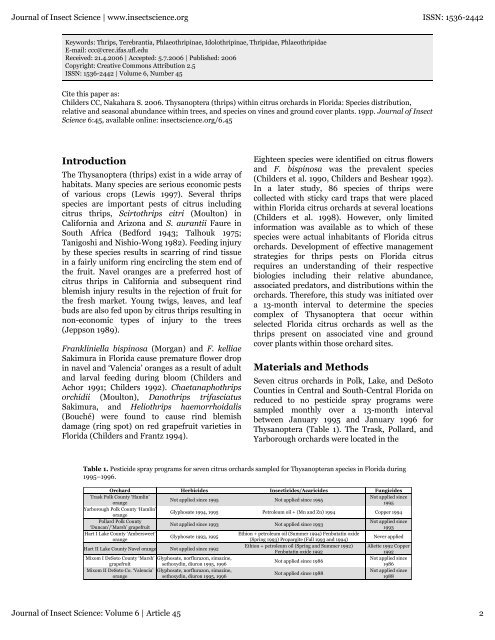Thysanoptera (thrips) within citrus orchards in Florida: Species ...
Thysanoptera (thrips) within citrus orchards in Florida: Species ...
Thysanoptera (thrips) within citrus orchards in Florida: Species ...
You also want an ePaper? Increase the reach of your titles
YUMPU automatically turns print PDFs into web optimized ePapers that Google loves.
Journal of Insect Science | www.<strong>in</strong>sectscience.org ISSN: 1536-2442<br />
Keywords: Thrips, Terebrantia, Phlaeothrip<strong>in</strong>ae, Idolothrip<strong>in</strong>ae, Thripidae, Phlaeothripidae<br />
E-mail: ccc@crec.ifas.ufl.edu<br />
Received: 21.4.2006 | Accepted: 5.7.2006 | Published: 2006<br />
Copyright: Creative Commons Attribution 2.5<br />
ISSN: 1536-2442 | Volume 6, Number 45<br />
Cite this paper as:<br />
Childers CC, Nakahara S. 2006. <strong>Thysanoptera</strong> (<strong>thrips</strong>) <strong>with<strong>in</strong></strong> <strong>citrus</strong> <strong>orchards</strong> <strong>in</strong> <strong>Florida</strong>: <strong>Species</strong> distribution,<br />
relative and seasonal abundance <strong>with<strong>in</strong></strong> trees, and species on v<strong>in</strong>es and ground cover plants. 19pp. Journal of Insect<br />
Science 6:45, available onl<strong>in</strong>e: <strong>in</strong>sectscience.org/6.45<br />
Introduction<br />
The <strong>Thysanoptera</strong> (<strong>thrips</strong>) exist <strong>in</strong> a wide array of<br />
habitats. Many species are serious economic pests<br />
of various crops (Lewis 1997). Several <strong>thrips</strong><br />
species are important pests of <strong>citrus</strong> <strong>in</strong>clud<strong>in</strong>g<br />
<strong>citrus</strong> <strong>thrips</strong>, Scirto<strong>thrips</strong> citri (Moulton) <strong>in</strong><br />
California and Arizona and S. aurantii Faure <strong>in</strong><br />
South Africa (Bedford 1943; Talhouk 1975;<br />
Tanigoshi and Nishio-Wong 1982). Feed<strong>in</strong>g <strong>in</strong>jury<br />
by these species results <strong>in</strong> scarr<strong>in</strong>g of r<strong>in</strong>d tissue<br />
<strong>in</strong> a fairly uniform r<strong>in</strong>g encircl<strong>in</strong>g the stem end of<br />
the fruit. Navel oranges are a preferred host of<br />
<strong>citrus</strong> <strong>thrips</strong> <strong>in</strong> California and subsequent r<strong>in</strong>d<br />
blemish <strong>in</strong>jury results <strong>in</strong> the rejection of fruit for<br />
the fresh market. Young twigs, leaves, and leaf<br />
buds are also fed upon by <strong>citrus</strong> <strong>thrips</strong> result<strong>in</strong>g <strong>in</strong><br />
non-economic types of <strong>in</strong>jury to the trees<br />
(Jeppson 1989).<br />
Frankl<strong>in</strong>iella bisp<strong>in</strong>osa (Morgan) and F. kelliae<br />
Sakimura <strong>in</strong> <strong>Florida</strong> cause premature flower drop<br />
<strong>in</strong> navel and ‘Valencia’ oranges as a result of adult<br />
and larval feed<strong>in</strong>g dur<strong>in</strong>g bloom (Childers and<br />
Achor 1991; Childers 1992). Chaetanapho<strong>thrips</strong><br />
orchidii (Moulton), Dano<strong>thrips</strong> trifasciatus<br />
Sakimura, and Helio<strong>thrips</strong> haemorrhoidalis<br />
(Bouché) were found to cause r<strong>in</strong>d blemish<br />
damage (r<strong>in</strong>g spot) on red grapefruit varieties <strong>in</strong><br />
<strong>Florida</strong> (Childers and Frantz 1994).<br />
Eighteen species were identified on <strong>citrus</strong> flowers<br />
and F. bisp<strong>in</strong>osa was the prevalent species<br />
(Childers et al. 1990, Childers and Beshear 1992).<br />
In a later study, 86 species of <strong>thrips</strong> were<br />
collected with sticky card traps that were placed<br />
<strong>with<strong>in</strong></strong> <strong>Florida</strong> <strong>citrus</strong> <strong>orchards</strong> at several locations<br />
(Childers et al. 1998). However, only limited<br />
<strong>in</strong>formation was available as to which of these<br />
species were actual <strong>in</strong>habitants of <strong>Florida</strong> <strong>citrus</strong><br />
<strong>orchards</strong>. Development of effective management<br />
strategies for <strong>thrips</strong> pests on <strong>Florida</strong> <strong>citrus</strong><br />
requires an understand<strong>in</strong>g of their respective<br />
biologies <strong>in</strong>clud<strong>in</strong>g their relative abundance,<br />
associated predators, and distributions <strong>with<strong>in</strong></strong> the<br />
<strong>orchards</strong>. Therefore, this study was <strong>in</strong>itiated over<br />
a 13-month <strong>in</strong>terval to determ<strong>in</strong>e the species<br />
complex of <strong>Thysanoptera</strong> that occur <strong>with<strong>in</strong></strong><br />
selected <strong>Florida</strong> <strong>citrus</strong> <strong>orchards</strong> as well as the<br />
<strong>thrips</strong> present on associated v<strong>in</strong>e and ground<br />
cover plants <strong>with<strong>in</strong></strong> those orchard sites.<br />
Materials and Methods<br />
Seven <strong>citrus</strong> <strong>orchards</strong> <strong>in</strong> Polk, Lake, and DeSoto<br />
Counties <strong>in</strong> Central and South-Central <strong>Florida</strong> on<br />
reduced to no pesticide spray programs were<br />
sampled monthly over a 13-month <strong>in</strong>terval<br />
between January 1995 and January 1996 for<br />
<strong>Thysanoptera</strong> (Table 1). The Trask, Pollard, and<br />
Yarborough <strong>orchards</strong> were located <strong>in</strong> the<br />
Table 1. Pesticide spray programs for seven <strong>citrus</strong> <strong>orchards</strong> sampled for <strong>Thysanoptera</strong>n species <strong>in</strong> <strong>Florida</strong> dur<strong>in</strong>g<br />
1995–1996.<br />
Orchard Herbicides Insecticides/Acaricides Fungicides<br />
Trask Polk County ‘Haml<strong>in</strong>’<br />
Not applied s<strong>in</strong>ce<br />
Not applied s<strong>in</strong>ce 1995 Not applied s<strong>in</strong>ce 1995<br />
orange<br />
1995<br />
Yarborough Polk County ‘Haml<strong>in</strong>’<br />
Glyphosate 1994, 1995 Petroleum oil + (Mn and Zn) 1994 Copper 1994<br />
orange<br />
Pollard Polk County<br />
Not applied s<strong>in</strong>ce<br />
Not applied s<strong>in</strong>ce 1993 Not applied s<strong>in</strong>ce 1993<br />
‘Duncan’/’Marsh’ grapefruit<br />
1993<br />
Hart I Lake County ‘Ambersweet’<br />
Ethion + petroleum oil (Summer 1994) Fenbutat<strong>in</strong> oxide<br />
Glyphosate 1993, 1995<br />
Never applied<br />
orange<br />
(Spr<strong>in</strong>g 1993) Propargite (Fall 1993 and 1994)<br />
Ethion + petroleum oil (Spr<strong>in</strong>g and Summer 1992) Aliette 1992 Copper<br />
Hart II Lake County Navel orange Not applied s<strong>in</strong>ce 1992<br />
Fenbutat<strong>in</strong> oxide 1992<br />
1992<br />
Mixom I DeSoto County ‘Marsh’ Glyphosate, norflurazon, simaz<strong>in</strong>e,<br />
Not applied s<strong>in</strong>ce<br />
Not applied s<strong>in</strong>ce 1986<br />
grapefruit<br />
sethoxyd<strong>in</strong>, diuron 1995, 1996<br />
1986<br />
Mixom II DeSoto Co. ‘Valencia’ Glyphosate, norflurazon, simaz<strong>in</strong>e,<br />
Not applied s<strong>in</strong>ce<br />
Not applied s<strong>in</strong>ce 1988<br />
orange<br />
sethoxyd<strong>in</strong>, diuron 1995, 1996<br />
1988<br />
Journal of Insect Science: Volume 6 | Article 45 2
















